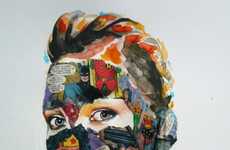
Hannah Wheeler Tells the Story of the Man on the Moon Through Art
Gil Cohen — March 18, 2013 — Art & Design
References: behance.net & ianbrooks.me
Illustrator Hannah Wheeler takes the old notion of the story of the man on the moon, and decides to portray him as a giant who is always looking out for us.
Her graphic novel style of illustration require no words or dialogue, the images alone are enough to convey the entire tale of a lonely being on the moon who wants to befriend Earth. Furthermore, his attempts at making contact with Earth are in fact the causes of many historically significant events. For example, Stonehenge and the pyramids are carvings he flung over as gifts and Newton got hit in the head by a pebble the giant kicked over in frustration.
Wheeler tells the story of the man on the moon within historical contexts.
Her graphic novel style of illustration require no words or dialogue, the images alone are enough to convey the entire tale of a lonely being on the moon who wants to befriend Earth. Furthermore, his attempts at making contact with Earth are in fact the causes of many historically significant events. For example, Stonehenge and the pyramids are carvings he flung over as gifts and Newton got hit in the head by a pebble the giant kicked over in frustration.
Wheeler tells the story of the man on the moon within historical contexts.
Trend Themes
1. Interactive Storytelling - Exploring the use of graphics and illustrations to convey a narrative without the use of words or dialogue presents opportunities for interactive storytelling experiences.
2. Mythology Reinvented - Reimagining traditional stories and myths, like the man on the moon tale, through innovative graphic novel styles opens possibilities for disrupting and revitalizing familiar narratives.
3. Historical Fiction Fusion - Blending historical contexts with fictional elements, such as attributing significant events to the actions of the man on the moon, offers avenues to create engaging and captivating forms of historical fiction.
Industry Implications
1. Publishing - Publishers can explore the use of graphic novel techniques and interactive storytelling to enhance traditional book formats, providing readers with a unique and immersive reading experience.
2. Entertainment - The entertainment industry can leverage mythology reinvented through innovative graphic novel styles as inspiration for new films, television shows, or video games that captivate audiences with fresh interpretations of familiar narratives.
3. Education - Educational institutions can incorporate historical fiction fusion into curricula to make history more engaging and relatable for students, offering a creative and interactive approach to learning.
0.9
Score
Popularity
Activity
Freshness























